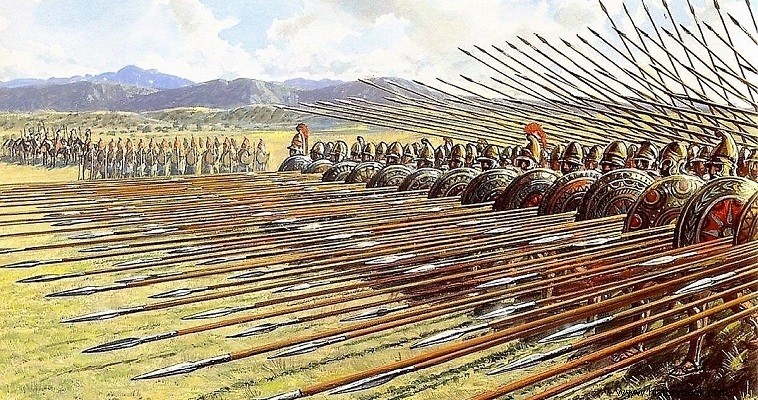
The Macedonian Phalanx, as a formation, had a catalytic effect on world military history, influencing the thinking of great generals up to the 18th century. Although it is often heard that the phalanx was a rigid, monolithic formation this is not the case, at least in the time of Alexander and his immediate successors.
The basic subunit of the phalanx was the element, which had a strength of 16 men and was called a company . Each line was headed by the captain and they lined up first. The last man was called a corporal and was equivalent to today's corporal. Two lines – 32 men – constituted a division and four companies a tetrarchy – 64 men.
Four tetrarchy made up a regiment of 256 men . This was also the lowest tactical unit of the phalanx. Two regiments made up a Pentasiarch, two Pentasiarchs a Thousand and three Pentasiarchs a Class (brigade). Later, in the times of the Descendants, the Order consisted of two dynasties. Two millarchies constituted a Division. Two divisions made up a Phalangarchy and two Phalangarchies a Horn.
The regiments of the phalanx were arranged in formation with a front of 16 men and a depth of 16 men (16 x 16 =256). Depending on the tactical situation they could dilute or thicken their formation. In the battle of Issus, the phalanx fought in a depth of only 8 yoke (men), instead of the usual 16. In the battle of Magnesia, against the Romans, in 190 BC. the Seleucid phalanx was lined up 32 men deep.
However, the usual formation was with a front of 16 and a depth of men. The regiments of a class were not all lined up together, parallel, without gaps between them. A small gap was usually left, in the approach phase, through which lightly armed lancers (archers, slingers, javelinmen) could pass in front of the phalanx, harassing the enemy with projectiles. Just before the attack of the heavy troops, the skirmishers, passing through the gaps, gathered behind the phalanx.
In the approach phase, the phalanx marched in an "open" formation, with the men about 1m apart. one from the other. However, as he approached the enemy and began to receive the enemy's projectiles, the phalanx "allied", with the men occupying, each front, about 60 cm., that is, the diameter of his shield. In this way, each regiment of the phalanx presented a front of less than 10 m.
But here was also the secret of success, as on the front of 10m. the Macedonian phalanx threw 256 men into battle, with the first 76 fighting directly and the rest adding depth to the formation and immediately replacing any losses. No other formation allowed such a large volume of men to be gathered in such a limited space. The Persians, due to armament and tactics, on a front of 10 m. could not gather more than 30 men.
So the phalanx enjoyed local numerical – in addition to qualitative – superiority in space and place. Even the southern Greek hoplites, because of their Argolic shield, 90 cm in diameter. they could not achieve such concentration. Moreover, due to the length of the spear, only the first two pairs of lancers could fight against each opponent.
